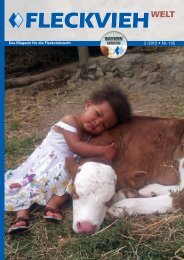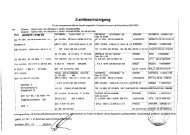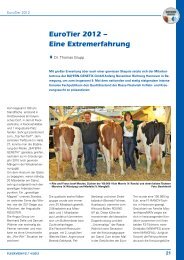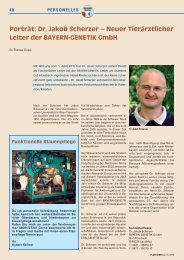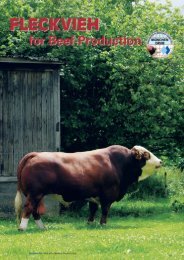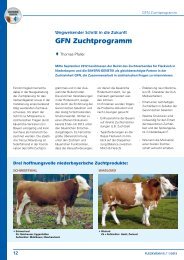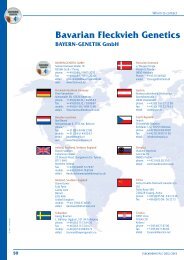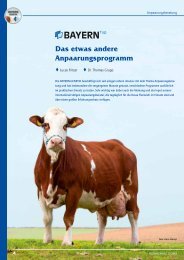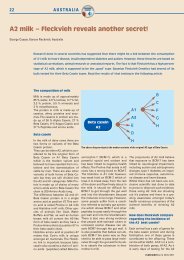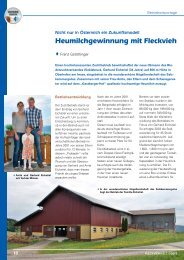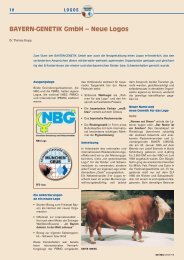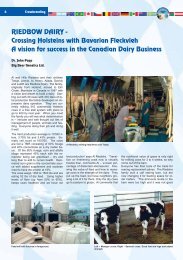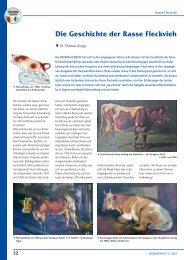Fleckvieh in Canada
Fleckvieh in Canada
Fleckvieh in Canada
Create successful ePaper yourself
Turn your PDF publications into a flip-book with our unique Google optimized e-Paper software.
4 CROSSBREEDING<br />
<strong>Fleckvieh</strong> <strong>in</strong> <strong>Canada</strong><br />
Dr. John Popp, Ph.D., Big Bear Genetics Ltd.<br />
F1 heifer,<br />
S: Enrico<br />
S<strong>in</strong>ce the May 2003 BSE case reported <strong>in</strong> <strong>Canada</strong>, the Canadian dairy export market to the United States<br />
has been at a standstill. This has resulted <strong>in</strong> lower replacement dairy heifer costs <strong>in</strong> <strong>Canada</strong> – an<br />
aspect which made expansion <strong>in</strong> <strong>Canada</strong> appeal<strong>in</strong>g. Back only a few years ago, most dairy producers<br />
would look to traditional dairy breeds to <strong>in</strong>crease herd size. Not only that, but certa<strong>in</strong>ly would not expect<br />
to pay more money for buy<strong>in</strong>g crossbreds vs. Holste<strong>in</strong>. However, some farmers recognized their<br />
chance and expanded their herds with <strong>Fleckvieh</strong>. Read, what their experiences were and why they are<br />
now conv<strong>in</strong>ced that this was the right decision.<br />
Young Dairy farmers expand by purchas<strong>in</strong>g <strong>Fleckvieh</strong> F1 crosses at a<br />
premium: 2 years later… was it a worthwhile <strong>in</strong>vestment?<br />
Cornel and Cremona Primrose, Alberta<br />
Cornel and Cremona Primrose expanded<br />
their dairy 1.5 years ago<br />
purchas<strong>in</strong>g Holste<strong>in</strong>s from a<br />
Holste<strong>in</strong> breeder dispersal sale as<br />
well as <strong>Fleckvieh</strong> F1 crosses from<br />
a fellow <strong>Fleckvieh</strong> breeder <strong>in</strong><br />
Manitoba. Follow<strong>in</strong>g is a very brief<br />
report on Canadian Dairy Herd<br />
The Primroses rise their crossbreds on the pasture.<br />
Improvement (DHI) data for 2<br />
cows specifically as they are identical<br />
for the days <strong>in</strong> milk <strong>in</strong>to the<br />
second lactation; both entered the<br />
herd at a similar time as Primrose<br />
dairy expanded. One be<strong>in</strong>g a<br />
<strong>Fleckvieh</strong> * Holste<strong>in</strong> sired by<br />
Hippo that they purchased from<br />
Test day milk Fat % Prote<strong>in</strong> % Days <strong>in</strong> Milk Milk to date SCC <strong>in</strong> ‘000<br />
Liters (Lbs) Liters (Lbs)<br />
June 12<br />
Holste<strong>in</strong> 35.5 (78.2) 2.8 2.9 15 517 (1138.8) 37<br />
F1 (FV x HF) 33.5 (73.8) 3.4 3.5 15 489 (1077.1) 17<br />
July 16<br />
Holste<strong>in</strong> 27.9 (61.5) 2.4 2.5 49 1568 (3453.7) 158<br />
F1 (FV x HF) 33.8 (74.4) 3.0 2.8 49 1644 (3621.1) 24<br />
Riedbow dairy <strong>in</strong> Manitoba, the<br />
other be<strong>in</strong>g a registered Holste<strong>in</strong><br />
purchased from a breeder dispersal<br />
sale <strong>in</strong> Alberta. Both animals<br />
had their second calves on<br />
May 28, 2007 and at the time of<br />
writ<strong>in</strong>g DHI data is available for<br />
12 June, 2007 and 16 July, 2007<br />
for second lactations.<br />
While these are only two animals,<br />
the data is consistent also with results<br />
from other dairies that have<br />
been breed<strong>in</strong>g with <strong>Fleckvieh</strong> and<br />
are now <strong>in</strong> a position where they<br />
are milk<strong>in</strong>g <strong>Fleckvieh</strong> crosses. At<br />
49 days <strong>in</strong> milk, the consistency of<br />
the flat lactation of <strong>Fleckvieh</strong> is<br />
evident. At a very hot time of the<br />
year, the Primrose’s feel that their<br />
<strong>Fleckvieh</strong> crosses succumb less to<br />
heat stress and ma<strong>in</strong>ta<strong>in</strong> more<br />
consistent production. Production<br />
numbers <strong>in</strong> Canadian dairies have<br />
F1 crosses produc<strong>in</strong>g 25 to 32 liters<br />
(55 to 70 lbs) with second lactations<br />
consistently 8 to 10 liters<br />
(17 to 22 lbs) higher. While data is<br />
very limited to date on somatic<br />
cell count, the DHI recorded <strong>Fleckvieh</strong><br />
crossbreds to date are averag<strong>in</strong>g<br />
60’000 to 80’000 below the<br />
herd average.<br />
When speak<strong>in</strong>g with Cremona and<br />
Cornel they both feel that the decision<br />
to spend more money on<br />
<strong>Fleckvieh</strong> crossbreds will be rewarded<br />
with more profit. They expect<br />
that the longevity on the<br />
crossbreds will be greater.<br />
FLECKVIEHWorld 2007
One million liters of <strong>Fleckvieh</strong> milk <strong>in</strong> the tank… it just keeps on go<strong>in</strong>g<br />
Riedbow Dairy, Manitoba<br />
Riedbow dairy started us<strong>in</strong>g <strong>Fleckvieh</strong><br />
to cross on their Holste<strong>in</strong> dairy<br />
herd <strong>in</strong> 2001. S<strong>in</strong>ce then they<br />
have also done a substantial herd<br />
expansion. Six years later, they<br />
are milk<strong>in</strong>g 143 <strong>Fleckvieh</strong> crosses;<br />
some already <strong>in</strong> their second lactations.<br />
With a current average at<br />
1.3 lactations (more and more<br />
young stock is still enter<strong>in</strong>g the<br />
herd) on the <strong>Fleckvieh</strong> crosses<br />
compared to the current Holste<strong>in</strong><br />
herd at 2.9 lactations the <strong>Fleckvieh</strong><br />
crosses are now runn<strong>in</strong>g 5 to 7%<br />
beh<strong>in</strong>d for production.<br />
Ale Riedstra and I had an opportunity<br />
<strong>in</strong> the w<strong>in</strong>ter months to travel<br />
to Alberta to speak with some more<br />
dairy farmers about <strong>Fleckvieh</strong><br />
cross<strong>in</strong>g and one pr<strong>in</strong>cipal<br />
question kept com<strong>in</strong>g up. Why is<br />
Riedbow dairy breed<strong>in</strong>g F1 crosses<br />
after a voluntary wait<strong>in</strong>g period<br />
of down as low as 45 days<br />
postpartum. Ale Riedstra’s answer<br />
is simple: “Because I can drop days<br />
<strong>in</strong> milk and I can move my F1’s<br />
<strong>in</strong>to their second lactation faster.<br />
We know they will produce 8 to 10<br />
liters (17 to 22 lbs) more and the<br />
animals can easily manage the<br />
transition; Cumulative production<br />
over time – <strong>in</strong>clud<strong>in</strong>g the dry period<br />
will be higher and the longevity<br />
of the animal will put more money<br />
<strong>in</strong> the tank”. When asked to back<br />
what he says – Ale came up with a<br />
valuation on cow longevity. The<br />
cost of <strong>in</strong>troduc<strong>in</strong>g a heifer to the<br />
milk<strong>in</strong>g herd ranges somewhere<br />
from $1800 to $2200. Generally<br />
speak<strong>in</strong>g the animal has to complete<br />
200 or more days <strong>in</strong> milk <strong>in</strong><br />
the first lactation to pay for that<br />
cost. The real money is made <strong>in</strong><br />
the second and third lactations.<br />
Ale is also confident from experience<br />
that the <strong>Fleckvieh</strong> crosses<br />
can handle a 45 day dry period, if<br />
need be. For the sake of this calculation,<br />
however, the determ<strong>in</strong>ation<br />
is done on a 60 day dry period.<br />
Typical F1 cross production <strong>in</strong> first<br />
lactation > 8000 liters on 315 days.<br />
Typical Holste<strong>in</strong> production <strong>in</strong> first<br />
lactation > 8700 liters on 345 days.<br />
Typical <strong>in</strong>tercalv<strong>in</strong>g period on dairies<br />
us<strong>in</strong>g <strong>Fleckvieh</strong> is 0.7 to 1.o<br />
month below previous production.<br />
<strong>Fleckvieh</strong> to date is consi-<br />
FLECKVIEHWorld 2007<br />
stently add<strong>in</strong>g 1 to 1.5 lactations to<br />
herd average. The data below are<br />
consistent with production numbers<br />
at Riedbow.<br />
This is provided as a simple method<br />
of determ<strong>in</strong><strong>in</strong>g the value of<br />
longevity. An additional calf, the<br />
reduced replacement rate, reduced<br />
health and breed<strong>in</strong>g costs all<br />
represent values of the <strong>Fleckvieh</strong>.<br />
Further herd data is presented below<br />
on the production of <strong>Fleckvieh</strong><br />
crosses <strong>in</strong>to their second lactation<br />
at Riedbow dairy. While we don’t<br />
suggest that <strong>Fleckvieh</strong> crosses<br />
CROSSBREEDING 5<br />
may outperform straight dairy<br />
breeds, we are confident that longevity<br />
and fertility can be added<br />
us<strong>in</strong>g <strong>Fleckvieh</strong>. Riedbow dairy is<br />
confident <strong>in</strong> the decision they have<br />
made <strong>in</strong> pursu<strong>in</strong>g <strong>Fleckvieh</strong><br />
and feel that many aspects of this<br />
dual purpose breed will add to<br />
their farm. So the next time a<br />
<strong>Fleckvieh</strong> breeder tells you that he<br />
does not want his heifers milk<strong>in</strong>g<br />
too hard <strong>in</strong> the first lactation – he<br />
has good reason. He knows his<br />
cows are go<strong>in</strong>g to stay around<br />
and they will make the money<br />
when they are grown up.<br />
Huge milk<strong>in</strong>g facility at Riedbow dairy. The Riedstra family is satisfied with the udder quality<br />
of <strong>Fleckvieh</strong>.<br />
Production results on <strong>Fleckvieh</strong> crosses with first lacations completed<br />
and <strong>in</strong>to second lactation at Riedbow dairy – June 17, 2007<br />
F1 sire 1 st lactation Production 2 nd lactation Production Days pregnant<br />
Days <strong>in</strong> milk Liters (Lbs) Days <strong>in</strong> milk Liters (Lbs) 2 nd lactation<br />
Hippo 358 8290 (18260) 226 7600 (16740) 167<br />
Hippo 346 9640 (21233) 153 4870 (10727) 87<br />
Manager 280 8100 (17841) 239 7680 (16916) 211<br />
Manager 286 8150 (17951) 259 8320 (18326) 223<br />
Samurai 355 9450 (20814) 186 6700 (14758) 121<br />
Samurai 362 10160 (22379) 108 4080 (8987) 108<br />
Enrico 373 9370 (20639) 83 3440 (7577) Bred, not vet confirmed<br />
Enrico 307 7260 (15991) 145 4700 (10352) 145<br />
Enrico 327 9700 (21366) 70 3030 (6674) Bred, not vet confirmed<br />
Enrico 267 6880 (15154) 169 5750 (12665) 98<br />
Enrico 324 7290 (16057) 59 2160 (4758) Bred, not vet confirmed<br />
Enrico 299 7680 (16916) 17 800 (1762) Fresh<br />
Randy 289 8120 (17885) 164 6410 (14119) 121<br />
Randy 359 9910 (21828) 93 2530 (5573) Bred, not vet confirmed<br />
Haxzeus 291 8790 (19361) 157 4030 (8877) 87<br />
Haxzeus 336 9490 (20903) 49 2280 (5022) Not bred yet
6 CROSSBREEDING<br />
The <strong>Fleckvieh</strong> F1 cross<br />
1st lactation 8000 liters <strong>in</strong> 315 days /60 days dry<br />
2nd lactation 9600 liters <strong>in</strong> 305 days/60 days dry<br />
3rd lactation 10600 liters 315 days<br />
Cumulative lifetime production 935 days <strong>in</strong> milk/120 days dry /<br />
2 calves<br />
In 1055 days the animal produced 28200 liters or 26.7 liters /day<br />
The Holste<strong>in</strong><br />
1st lactation 8900 liters <strong>in</strong> 345 days/ 60 days dry<br />
2nd lactation 11200 liters <strong>in</strong> 320 days<br />
Cumulative lifetime production on 665 days <strong>in</strong> milk/ 60 days<br />
dry/1 calf.<br />
In 725 days a total of 20’200 liters or a daily production of<br />
27.7 liters was realized.<br />
Crossbred cows from the Riedstra family<br />
are <strong>in</strong> high demand – this Manager daughter<br />
was sold from Manitoba to Alberta.<br />
My father, Werner –<br />
an <strong>in</strong>telligent man, a<br />
man of amaz<strong>in</strong>g vision<br />
and unmatched<br />
drive. Dad grew up <strong>in</strong><br />
the ru<strong>in</strong>s of the<br />
Second World War. In<br />
his years of high<br />
school he met the love<br />
of his life, Monika.<br />
Before their marria-<br />
Werner Popp on his farm <strong>in</strong> Manige,<br />
Werner was offetoba,<br />
<strong>Canada</strong>.<br />
red the opportunity to do a masters<br />
<strong>in</strong> bus<strong>in</strong>ess adm<strong>in</strong>istration <strong>in</strong> Boulder,<br />
Colorado. Dad began his career<br />
work<strong>in</strong>g for a consult<strong>in</strong>g firm<br />
and Monika and him struggled to<br />
make ends meet when their children<br />
were born. Shortly <strong>in</strong>to his career,<br />
Werner started his own suc-<br />
Above numbers show production<br />
for <strong>Fleckvieh</strong> crosses com<strong>in</strong>g <strong>in</strong>to<br />
second lactation. At the time of<br />
writ<strong>in</strong>g 145 <strong>Fleckvieh</strong> crosses have<br />
entered the barn. Of those 2 animals<br />
had to be taken out of the<br />
barn, one because she was dripp<strong>in</strong>g<br />
milk and one because her<br />
production was low. Those ani-<br />
In memory of Werner Georg Popp, Dipl. V.W., MBA<br />
Born – 10.10.1940 Hirschau, Oberpfalz, Germany/Died – 30.3.2007 Erickson, Manitoba, <strong>Canada</strong><br />
Dr. John Popp, Big Bear Genetics Ltd.<br />
cessful consult<strong>in</strong>g bus<strong>in</strong>ess. By the<br />
early 1980’s he had saved enough<br />
money to pursue his dream of once<br />
aga<strong>in</strong> be<strong>in</strong>g a farmer. This led him<br />
to move his family to <strong>Canada</strong> <strong>in</strong><br />
1983 to beg<strong>in</strong> a beef and gra<strong>in</strong><br />
farm. It was a tough decision to<br />
move to another country and farm;<br />
he wanted the very best for his family,<br />
he wanted his sons to be well<br />
educated. The oldest, Max, is now a<br />
veter<strong>in</strong>arian, the second son,<br />
Michael, an agriculture professor.<br />
My work has been beef, grassland<br />
and dairy research and extension<br />
and I have been back on the family<br />
farm s<strong>in</strong>ce 1998. N<strong>in</strong>e years ago,<br />
Monika left Werner’s side and he<br />
had to face a tough and lonely time<br />
after her death.<br />
mals are still on the farm be<strong>in</strong>g<br />
used as suckler cows. At an average<br />
of 1.3 lactations, the <strong>Fleckvieh</strong><br />
crosses have a milk<strong>in</strong>g speed of<br />
6.9 m<strong>in</strong>utes with a 305 day adjusted<br />
production at 8961 liters.<br />
Riedbow dairy is satisfied with the<br />
udder quality of <strong>Fleckvieh</strong>, feet<br />
and legs as well as overall health.<br />
A young boy, Werner grew up <strong>in</strong> the years of the war on a farm <strong>in</strong> Germany. He grew up milk<strong>in</strong>g <strong>Fleckvieh</strong><br />
cows and <strong>in</strong> the years of his life he did th<strong>in</strong>gs that can be unmatched by many. In the end, he<br />
was <strong>in</strong>strumental <strong>in</strong> br<strong>in</strong>g<strong>in</strong>g the <strong>Fleckvieh</strong> breed to the dairy <strong>in</strong>dustry of North America with Bavarian<br />
<strong>Fleckvieh</strong> Genetics of Muenchen Grub.<br />
While most people might th<strong>in</strong>k of<br />
retir<strong>in</strong>g, dad started the ‘<strong>Fleckvieh</strong>’<br />
chapter’ <strong>in</strong> his life. He went to Germany,<br />
met Dr. Grupp – asked him<br />
to come to <strong>Canada</strong> and meet his<br />
family. From there, the two proceeded<br />
to <strong>in</strong>troduce Bavarian <strong>Fleckvieh</strong><br />
to dairies <strong>in</strong> <strong>Canada</strong>. With time, dad<br />
guided my brother Max and I to take<br />
on more and more of the daily<br />
work of promot<strong>in</strong>g <strong>Fleckvieh</strong>.<br />
My father was an amaz<strong>in</strong>g man –<br />
he loved the <strong>Fleckvieh</strong> breed and I<br />
am proud to say that he taught me<br />
a lot and he was my father.<br />
I am honoured to cont<strong>in</strong>ue to work<br />
with Bavarian <strong>Fleckvieh</strong> now as I<br />
share his passion and love for the<br />
breed.<br />
FLECKVIEHWorld 2007
How do <strong>Fleckvieh</strong> crosses perform<br />
<strong>in</strong> the feed pen?<br />
John Popp, Ph.D., Big Bear Genetics Ltd.<br />
We worked with some of our dairies<br />
<strong>in</strong> the retention of the bull calves<br />
for grow<strong>in</strong>g and f<strong>in</strong>ish<strong>in</strong>g. We<br />
all know that with cont<strong>in</strong>ued impend<strong>in</strong>g<br />
upward pressure on feed<br />
gra<strong>in</strong> prices, the cost of feed fed to<br />
the dairy cow will rise. Concurrent<br />
to that – growers also become<br />
concerned as steers and heifers<br />
are raised. In this article we will take<br />
a brief look at the growth performance<br />
of the <strong>Fleckvieh</strong>* dairy<br />
cross steers, fed concurrent with<br />
beef steers and dairy steers. The<br />
pr<strong>in</strong>cipal question is – is there money<br />
<strong>in</strong> grow<strong>in</strong>g and f<strong>in</strong>ish<strong>in</strong>g animals?<br />
Do <strong>Fleckvieh</strong> crosses perform<br />
<strong>in</strong> the feed pen? Do they convert<br />
feed more efficiently? Do they<br />
have the same number of days on<br />
feed? While these numbers are<br />
CROSSBREEDING 7<br />
Why would anyone <strong>in</strong> their right m<strong>in</strong>d talk about beef when talk<strong>in</strong>g about a milk cow? Strange to say that<br />
when most everyone that first looks at <strong>Fleckvieh</strong> tells us – „these cows are too beefy”. It is well established<br />
now that they are milk<strong>in</strong>g well <strong>in</strong> the US and <strong>Canada</strong> and dairymen us<strong>in</strong>g <strong>Fleckvieh</strong> now tell us just the<br />
opposite – „We get the same amount of milk as before – and we get the beef and other positive traits for<br />
free”. Some even tell us that they would like to see more ‘substance’ on some of their F1’s. This is why they<br />
cont<strong>in</strong>ue to absorption cross with <strong>Fleckvieh</strong> to get an F2 and F3 animal.<br />
Grade and Yield Comparison of <strong>Fleckvieh</strong>*Holste<strong>in</strong>,<br />
Holste<strong>in</strong> and common North American beef steers<br />
Hereford*Angus<br />
Hereford*Angus<br />
Limous<strong>in</strong>e*Angus<br />
Limous<strong>in</strong>e*Angus<br />
Average<br />
Holste<strong>in</strong><br />
Holste<strong>in</strong><br />
Holste<strong>in</strong><br />
Average<br />
<strong>Fleckvieh</strong>*Holste<strong>in</strong><br />
<strong>Fleckvieh</strong>*Holste<strong>in</strong><br />
<strong>Fleckvieh</strong>*Holste<strong>in</strong><br />
<strong>Fleckvieh</strong>*Holste<strong>in</strong><br />
<strong>Fleckvieh</strong>*Holste<strong>in</strong><br />
Average<br />
FLECKVIEHWorld 2007<br />
just start<strong>in</strong>g to come to light <strong>in</strong><br />
North America, we have the opportunity<br />
to show some results.<br />
These data are from the Hauste<strong>in</strong><br />
dairy farm <strong>in</strong> Alberta where Doug,<br />
Bernadette, Calvert, Amanda and<br />
children and Conlee make their<br />
home. The cattle were fed <strong>in</strong> the<br />
same pens with equal access to<br />
water and feed and were a contemporary<br />
group on feed that were<br />
slaughtered and graded. Canadian<br />
carcasses provide yield data<br />
on the basis of removal of <strong>in</strong>ternal<br />
organs thus numbers are lower<br />
than <strong>in</strong> US system. AAA carcasses<br />
(A, AA, AAA characterization of<br />
<strong>in</strong>tramuscular marbl<strong>in</strong>g) are usually<br />
equivalent to upper 1/3 choice<br />
while double AA would equivalent<br />
to USDA choice, with some car-<br />
Days age at slaughter Live weight lbs. Railgrade weight lbs Grade* Yield<br />
(liver kidney out)<br />
575,0 1526,0 832,0 aa 60,0<br />
572,0 1508,0 821,0 aaa 57,0<br />
615,0 1403,0 897,0 aaa 62,0<br />
624,0 1415,0 883,0 aa 64,0<br />
596,5 1463,0 858,3 60,8<br />
712,0 1381,0 728,0 aa 61,0<br />
716,0 1381,0 739,0 aaa 62,0<br />
633,0 1227,0 633,0 aa 59,0<br />
687,0 1329,7 700,0 60,7<br />
511,0 1486,0 776,0 aa 61,0<br />
563,0 1572,0 826,0 aa 64,0<br />
588,0 1406,0 825,0 aa 64,0<br />
559,0 1455,0 784,0 aa 59,0<br />
550,0 1402,0 760,0 aa 63,0<br />
554,2 1464,2 794,2 62,2<br />
*Grade: a – trace marbl<strong>in</strong>g, aa – slight marbl<strong>in</strong>g, aaa – modest marbl<strong>in</strong>g<br />
<strong>Fleckvieh</strong> x Holste<strong>in</strong> crossbred steer – With ris<strong>in</strong>g feed gra<strong>in</strong> prices<br />
feed conversion becomes an even more important trait.<br />
<strong>Fleckvieh</strong> x Holste<strong>in</strong> crossbreds on the Hauste<strong>in</strong> Dairy grow faster<br />
and have a higher slaughter weight than the crossbreds between<br />
beef breeds.<br />
casses potentially fall<strong>in</strong>g to USDA<br />
select.<br />
The primary difference is seen <strong>in</strong><br />
the number of days on feed. Data<br />
from Europe and other feedlots<br />
also <strong>in</strong> the US are consistently<br />
show<strong>in</strong>g that <strong>Fleckvieh</strong> crossbreds<br />
will require 100 to 140 days less on<br />
feed to f<strong>in</strong>ish with equal or greater<br />
railgrade weight.This is why many<br />
of our customers us<strong>in</strong>g <strong>Fleckvieh</strong><br />
are see<strong>in</strong>g premiums for the<br />
crossbred bull calves. Favourable<br />
growth rates and feed conversion<br />
are also evident <strong>in</strong> the heifer rear<strong>in</strong>g<br />
programs.



